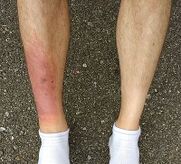Phototoxicity
Phototoxicity is an intensified, quantitatively altered skin reaction to sunlight in combination with local or general application of a photoactive drug.
Etiology[edit | edit source]
Increased sensitivity of the skin is caused by the pathological interaction of radiation and such chemical substances in the skin that are capable of absorbing radiation. In the past, it has been caused by the use of topical sulfonamides, phenothiazine derivatives (chlorpromazine), and etrachlorsalicylanilide. In recent years, the increasing incidence of abnormal sensitivity of the skin to sunlight is associated with the increase in the consumption of drugs and the chemicalization of life in the broadest sense of the word, with increasing individual exposures to ultraviolet (UV) radiation both from the sun and from artificial sources, especially solariums. An extensive group of photoactive substances includes various medicines, cosmetics and disinfectants, artificial sweeteners and food additives, plant substances, dyes in textiles, industrial substances, etc.[1]
Among drugs, the most common agents are antibiotics (tetracyclines, quinolones, sulfonamides), hormones (estrogens, progestogens), non-steroidal anti-inflammatory drugs, drugs for the cardiovascular system (amiodarone), diuretics, antidiabetics, etc.
Speeches[edit | edit source]
Typical clinical manifestations are redness and skin penetration in the irradiated areas, sometimes with the formation of blisters and necrosis. The local finding is accompanied by burning and soreness of the skin. The first symptoms often appear within a few minutes to hours after irradiation, followed by peeling of the skin, patients tend to have more permanent patchy hyperpigmentation. In general administration of photoactive drugs, the maximum manifestations are localized in the so-called solar predilection - mainly on the face, in the neckline and on the backs of the hands, the eyelids, subnasal and submental region are spared.[2]
Disease[edit | edit source]
- Photocontact dermatitis - after derivatives of etrachlorsalicylanilide
- skin tumor,
- acute dermatitis
Diagnostics[edit | edit source]
- Irradiated sheet (epicutaneous) tests - application of two samples on the skin of the back and after 24 hours irradiation of one sample with UV radiation.
Treatment[edit | edit source]
If a phototoxic reaction is detected, the sensitizing drug must be discontinued immediately. Therapy of acute conditions is only symptomatic - cooling compresses, corticosteroid ointments, generally we administer antihistamines.
Links[edit | edit source]
Related articles[edit | edit source]
References[edit | edit source]
DITRICHOVÁ, Dagmar. Photosensitive potential of drugs for external and general use [online]. [cit. 2017-04-23]. <http://www.medicinapropraxi.cz/pdfs/med/2008/10/10.pdf>.
- ↑ DOC. MUDR. DAGMAR DITRICHOVÁ, CSC,. FOTOSENZITIVNÍ POTENCIÁL LÉČIV P R O Z E V N Í I C E L K O V É P O U Ž I T Í PRO ZEVNÍ I CELKOVÉ POUŽITÍ [online]. [cit. 2017-04-23]. <http://www.medicinapropraxi.cz/pdfs/med/2008/10/10.pdf>.
- ↑ DOC. MUDR. DAGMAR DITRICHOVÁ, CSC,. FOTOSENZITIVNÍ POTENCIÁL LÉČIV P R O Z E V N Í I C E L K O V É P O U Ž I T Í PRO ZEVNÍ I CELKOVÉ POUŽITÍ [online]. [cit. 2017-04-23]. <http://www.medicinapropraxi.cz/pdfs/med/2008/10/10.pdf>.

